Teeth Whitening (Bleaching)
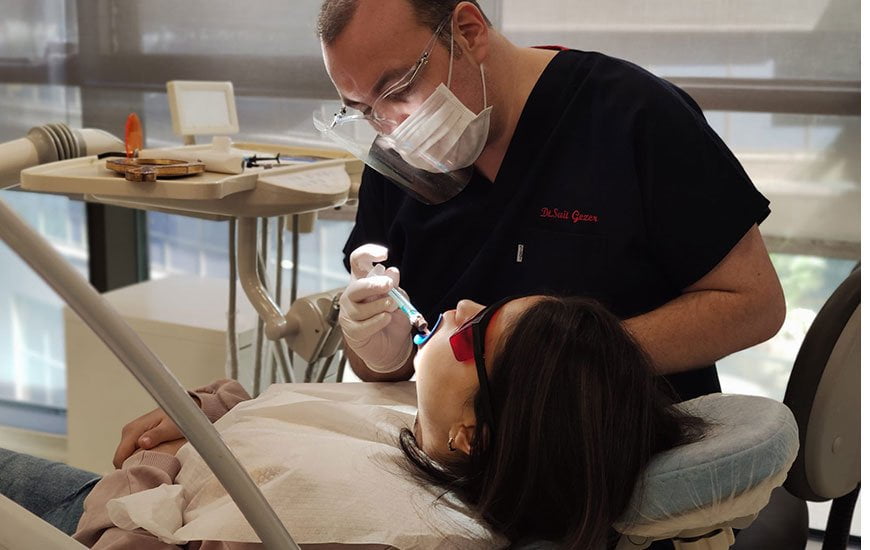
Although it’s everyone’s dream to have white teeth when they smile, this doesn’t always happen for different reasons. While the natural tooth color of some people is yellow, the teeth of some people may not have a white appearance due to their consumption habits during the day. Even if the teeth are brushed regularly, yellowing of the teeth cannot be prevented most of the time. This situation, which can negatively affect the self-confidence of people, can easily be removed from being a problem. In cases where the toothpastes and polishes used in daily life are not enough, teeth whitening methods can be applied. In addition, prosthetic teeth, veneers, zirconium and leaf porcelains are designed to be compatible with the patient’s teeth in terms of color. As they do not change their color over time, they do not change color with the teeth whitening process. Teeth whitening processes do not cause any harm to veneers and prostheses.
What is Teeth Whitening Bleaching?
The process of removing the discoloration that penetrates the enamel and dentin layers of the teeth for various reasons and bleaching the teeth according to their previous tone is called teeth whitening (Bleaching). The darkening of the natural colors of the teeth over time can be removed by cleaning and polishing the teeth. However, with these applications, it is possible to remove the discoloration that cannot be removed or to lighten the natural color of the tooth a few more tones. In this case, the whitening method, which is known to be a more protective method, is applied instead of making porcelain on the teeth. After teeth whitening, in other words, after the bleaching process, up to 4-5 tons of lightening can be achieved depending on the condition of the teeth.
Is Teeth Whitening Permanent?
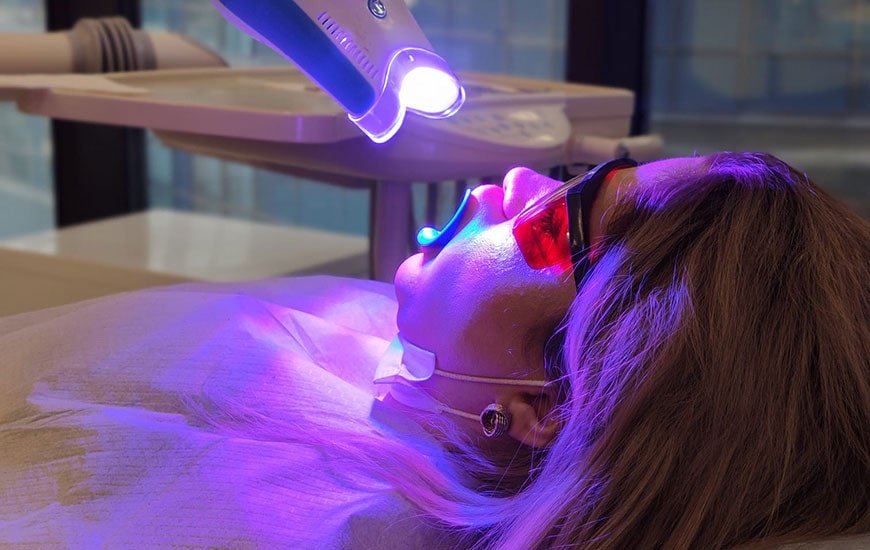 Although the result of teeth whitening varies depending on the tooth structure of the person, it is permanent between 6 months and 2 years on average. However, the teeth never return to their original color. Consuming substances such as coffee, cigarettes, red wine constantly and the person’s eating habits can cause the teeth to lose their whiteness. Because; If necessary, it can be checked 6 months after the teeth whitening process, and if necessary, dental calculus cleaning, polishing and a second session of teeth whitening can be recommended.
Although the result of teeth whitening varies depending on the tooth structure of the person, it is permanent between 6 months and 2 years on average. However, the teeth never return to their original color. Consuming substances such as coffee, cigarettes, red wine constantly and the person’s eating habits can cause the teeth to lose their whiteness. Because; If necessary, it can be checked 6 months after the teeth whitening process, and if necessary, dental calculus cleaning, polishing and a second session of teeth whitening can be recommended.
What are Teeth Whitening Techniques?
Teeth whitening methods are divided into two different types according to the application technique:
Office Type Tooth Bleaching: This method is a technique applied by the dentist in the clinical setting and provides a fast and effective result. In the office-type teeth whitening process, which consists of 2-3 sessions of approximately 15 minutes, the number of sessions can be increased or decreased according to the desired result and the tooth sensitivity of the person. Before starting the process, tartar cleaning should be done in order to increase the permanence. Before the teeth whitening process, the color of the tooth is selected, and a protective agent is applied to prevent damage to the gums. Teeth whitening chemical gel, which is a whitening product with a high oxygen content, is applied by activating it with various light sources, including lasers. After the gel is kept on the teeth for a certain period of time, it is cleaned and the tooth color is checked. Sessions are continued if necessary. In-office teeth whitening only affects the front eight teeth. It is useful to wait 24 hours for the full effect of the teeth whitening process to be seen.
Home Bleaching: It is a method that is performed outside the clinical environment with the help of plates or ready-to-use apparatus specially prepared for the person at home or at work. A special tooth whitening plate is prepared according to the measurement taken from the lower and upper jaw of the person. The dose is adjusted by the dentist by selecting the appropriate tooth whitening gel for the patient. During the specified time, the person puts the molds in which the tooth whitening gel is placed on their teeth. Since this application is more practical, it is generally preferred to be done at night. Care should be taken not to apply too much of the whitening gel in home teeth whitening procedures. If it is applied too much, the whitening gel that overflows from the plaque can irritate the gums. When faced with such a situation, it is recommended to wash the gums immediately and apply a cream containing vitamin E to the irritated surface.
The hydrogen peroxide concentration of home-applied whitening products is much lower than the teeth whitening products used by physicians in the clinical setting. As a natural result of this, it becomes possible to get very fast and effective results from office whitening procedures. In office bleaching procedures, the dentist provides full protection to the patient’s gums and soft tissues. In this way, the risk of irritating the gums by the whitening gel, which is at risk in home whitening processes, is not in question in office whitening processes. Optimum results can be achieved in office-type bleaching processes in terms of the patient’s health and the whitening effect achieved.
Diş Beyazlatma İşlemi Ne Kadar Sürüyor?
Diş beyazlatma işleminin kaç seans süreceği, dişteki renklenmeye bağlı olarak 2-3 seans arasında değişiklik gösteriyor. 15 dakikalık periyotlar halinde üç kez gerçekleştirilen diş beyazlatma işleminden önce diş etlerinin zarar görmesini engellemek için koruyucu madde sürülüyor. Ardından dişlere beyazlatıcı jel uygulaması yapılıyor.
How Much Are Teeth Whitening Prices?
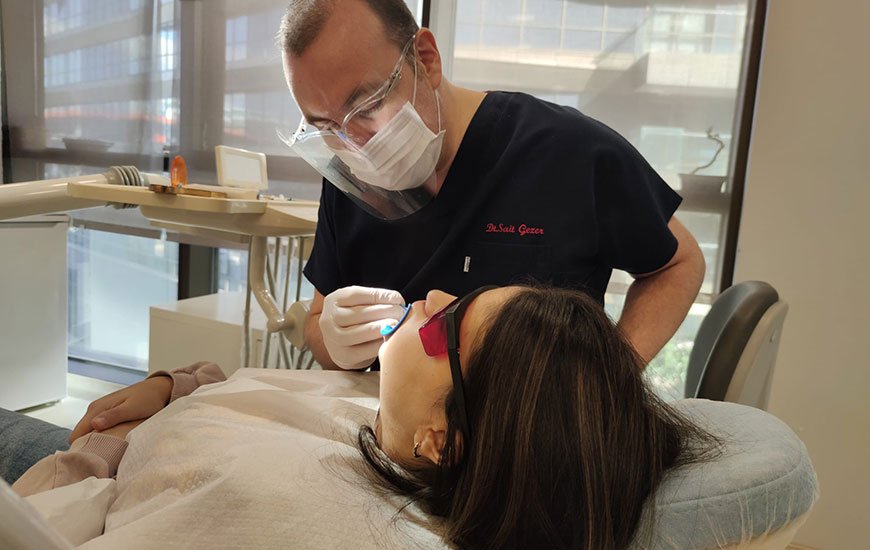
The cost of teeth whitening, which is one of the most important aesthetic and cosmetic treatments offered by dentists, is lower than other dental aesthetic treatments. At the same time, it can be applied quickly and results can be obtained in a short time. Teeth whitening process prices may vary depending on the method and devices to be applied. When it comes to teeth whitening prices determined according to many criteria; A patient-specific treatment plan and budget are created by examining factors such as the frequency of application sessions, whether tooth whitening methods are applied in combination or not. Home teeth whitening prices are more affordable than office teeth whitening.
What are the Teeth Whitening Methods?
Although having white teeth and an aesthetic appearance is very important for people of all age groups, regardless of men and women, this is not always possible due to different factors. Some people’s natural tooth color is yellow, while some people have discoloration on their teeth due to their eating and drinking habits. In this case, it may not be possible to prevent yellowing of the teeth, even if the teeth are brushed regularly and the correct oral and dental care is applied.
Some people’s teeth may be congenital, and some people’s teeth may have internal discoloration as a result of reasons such as the use of certain antibiotics. In addition, frequently consumed foods and beverages such as tea, coffee, wine, fruit juice can cause external discoloration on the teeth. As a result of these factors, the natural whiteness of the teeth can be shaded and the desired white teeth can be avoided.
However, there are some methods that can be applied to achieve the desired whiteness of the teeth. By using the bleaching process, it is possible to remove the discoloration of the teeth and achieve whiter teeth. However, teeth whitening, that is, bleaching, should not be confused with the polishing process applied after tartar cleaning. Tooth whitening, in other words bleaching procedure, can be applied with different methods.
Office Type Teeth Whitening (Clinical Whitening)
Office bleaching is a teeth whitening procedure applied by a dentist in a clinical setting. This procedure, which provides fast and effective results, is usually performed in 2-3 sessions of 15 minutes. The number of sessions to be applied varies according to the current situation in the teeth of the person, the tooth sensitivity of the person and the desired result. Before the in-office teeth whitening procedure is applied, the patient is cleaned with calculus in order to obtain a longer-lasting effect. After the desired tooth color is determined, preservatives are applied to prevent any damage to the gums during the procedure. In the office type teeth whitening procedure, tooth whitening chemical gels, which are whitening products containing high oxygen, are activated by using different light sources such as laser. After the applied gel is kept on the teeth for a certain period of time, it is cleaned and the resulting tooth color is checked. Sessions are continued if necessary. The office-type teeth whitening method, which provides effective whiteness in a short time, is a time-saving procedure for both the patient and the dentist. In order to ensure the permanence of the result obtained, it is very important to pay attention to certain points after the application. Temporary sensitivity may occur in the teeth after teeth whitening. This condition, which is considered natural, resolves spontaneously within a few days.
Laser Whitening (Light Whitening)
Laser whitening, a power-assisted whitening process that lightens enamel and dentin; This is accomplished using a full-arc bleach lamp and a light-activated 35% peroxide gel. This method, which is safe, effective and extremely fast, is ideal for people who want to have whiter teeth in a short time.
Laser whitening light-activated whitening gel can be described as a scientifically formulated, pH-balanced hydrogen peroxide that gently penetrates teeth to remove deep stains and discoloration. As a result of the breakdown of the hydrogen peroxide gel, oxygen enters the enamel and dentin. Thus, it provides whitening of colored substances without causing any change in the structure of the tooth.
Before the procedure, the lips and gums are isolated to avoid any damage. A light-activated whitening gel specially designed for 15-minute sessions is applied. After each 15-minute session, the whitening gel is rinsed and cleaned, and up to three sessions are repeated if necessary. Laser teeth whitening procedure is completed with a fluoride treatment that lasts for about 5 minutes.
Home Type Teeth Whitening
Home bleaching, in other words, home bleaching, is a teeth whitening procedure that is applied by the dentist at home, under the control of the dentist, but with the materials prepared by the dentist. The teeth whitening processes of the patients to whom home teeth whitening will be applied are planned individually by the dentist. In this context, personalized measurements and analyzes are made. As a result, individual plaques are prepared. On the plaques given by the dentist, the person applies the tooth whitening gel given by the dentist to the specified extent. In order for the home teeth whitening procedure to be successful, the plates must be used regularly for the period specified by the dentist. It is preferable to wear dental plaques at night, as it is generally more practical. One of the most important issues in home teeth whitening method is to adjust the amount of tooth whitening gel given by the dentist. If the whitening gel is applied more than normal, there is a risk that the plaques will overflow and irritate the gums. In such a situation, the gums should be cleaned by washing with plenty of water immediately and a cream containing vitamin E should be applied to the irritated surface.
Single Teeth Whitening (Internal Whitening of Root Canal Treated Teeth)
As a result of root canal treatment or trauma, as well as the use of foods and beverages with coloring properties such as tea, coffee, cigarettes, and red wine, the living tissue inside the tooth may die and discoloration may occur in the teeth. Discoloration can occur in all teeth, or in some cases, it can occur in a single tooth. In such cases, a single teeth whitening procedure is applied.
Single teeth whitening procedure is usually applied to teeth that have discoloration due to root canal treatment. The fillings in the teeth are removed. Teeth whitening gel is applied to the opened space. Teeth whitening with laser can be continued until the desired tone is achieved in the teeth that are tightly closed with a temporary filling. In this procedure, teeth whitening chemicals are activated by laser to achieve the desired whiteness.
The permanence of a single tooth whitening procedure may vary depending on the patient’s liquids that may cause discoloration and smoking status. If necessary, the result obtained from a single tooth whitening procedure can be made permanent by supporting it with 1-2 sessions every 4-6 months. Achieving the desired whitening of the teeth is a process that can vary according to the oral and dental health of the person.
Combined Teeth Whitening (Home+Office Type Whitening)
Combined teeth whitening is an effective teeth whitening procedure that can be applied to people who are not satisfied with the color of all their teeth. It can be preferred for changing the colors of the teeth that have discolored due to different reasons or to lighten the individual tooth color by a few tones. In this procedure, where home-type teeth whitening and office-type teeth whitening methods are applied together, the whiteness obtained after the office-type teeth whitening process is applied to the patient is supported by the home-type teeth whitening application. The application of this method is generally preferred in people with advanced coloration.
Our Customer Reviews
Our Patient Pictures
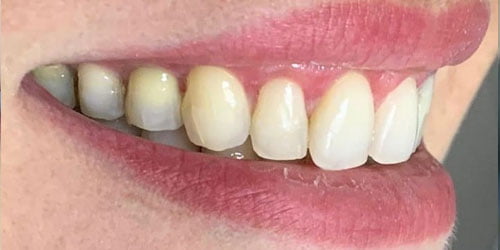
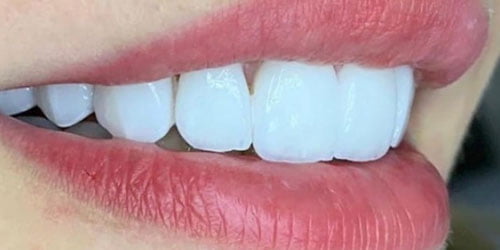
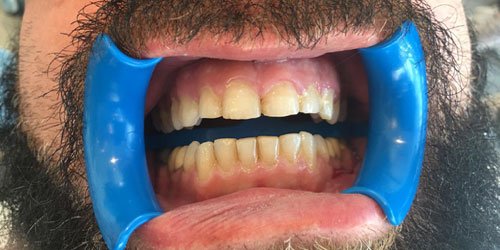
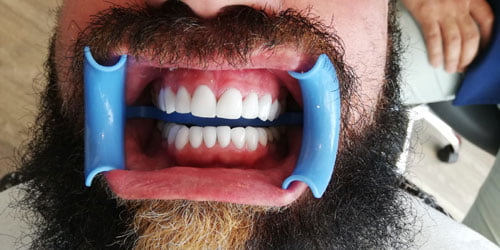
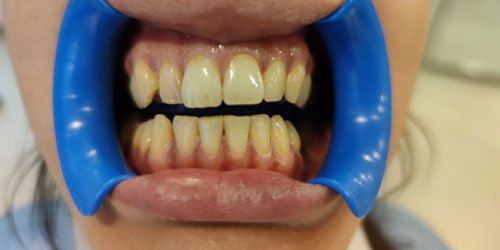
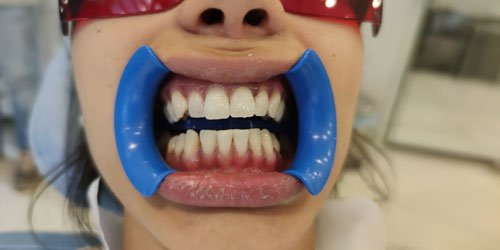
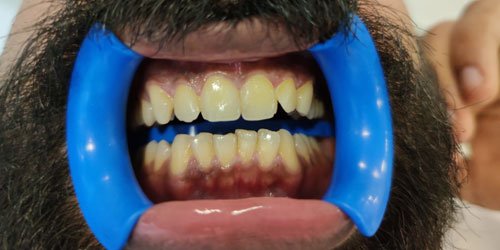
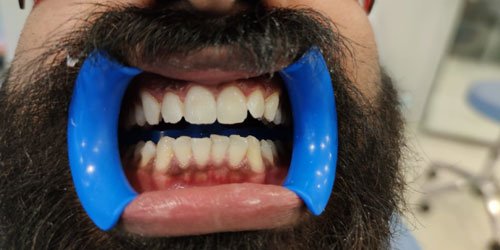
Frequently Asked Questions About Teeth Whitening
What is the Teeth Whitening Process?
The process of whitening tooth color by applying whitening agents to the enamel of the teeth. It is usually applied as hydrogen peroxide or carbamide peroxide. Home and office types are available. In the home type, whitening plates prepared with the measurements taken from the patient or whitening gels with ready-made plates are kept in the mouth and applied by the patient himself. In the office type, the possibility of damage to the gums is zeroed by applying a barrier to the gums under the control of the physician in the office environment. In addition, the process of the process is accelerated with blue light, much faster results are obtained compared to the house type.
How Long Does Teeth Whiteness Last?
It has a permanence between 1 and 3 years, depending on the amount of colorant used by the individual.
Is the Effect of Teeth Whitening Permanent?
Teeth whitening effect is permanent and never returns to its original color as the inner tooth color.
Does Teeth Whitening Damage Teeth?
There is no harm in teeth whitening when done at appropriate intervals.
I Have Sensitivity in My Teeth, Can I Still Have Whitening?
In order to eliminate the sensitivity of the teeth, fluoride applications are made after the application. If the sensitivity is not due to caries, fluoride application will be effective.
What is the Success Rate in the Whitening Process?
Very high success rates can be achieved in discoloration due to tea, coffee, smoking and aging. However, it may be more difficult to achieve the desired result in colorations known as fluorosis, which occur due to the use of certain drugs or excessive fluoride. At the same time, teeth whitening is not a procedure that gives the same results for everyone. As a result of the application, how much the color of the tooth will lighten is a situation that can vary according to the structure of the tooth. On the other hand, it is very important for the success of the application that the patient adheres to certain points in the near-term following the teeth whitening application.
At What Age Can Teeth Whitening Be Performed?
Teeth whitening procedure can be applied to people who have completed the age of 18 and who do not have any obstacle to the application in their teeth. Although she wants her teeth to be whiter and is over 18 years old; Teeth whitening is not applied to people who are undergoing cancer treatment, who have serious gum problems, who have some problems with the enamel surface of the tooth, who have excessive tooth sensitivity, whose gums have been pulled due to gum disease, and to pregnant women. In the same way, people with extensive caries and restorations such as fillings, which may not respond to whitening as desired in their anterior teeth and may cause color difference after the application, can also be whitened if the restorations are to be renewed.
Are There Any Situations In Which Teeth Whitening Should Not Be Done?
Teeth whitening procedure is not applied to people with poor oral hygiene, and oral hygiene should be improved first of all. If there are structural defects such as amelogenesis imperfecta and dentinogenesis imperfecta, which are related to enamel and dentin, the application is not performed because effective results cannot be obtained from the whitening process. Teeth with advanced tetracycline stains are not preferred to be whitened. In addition to these, teeth whitening procedure is not applied to people who have cracks, fractures, advanced sensitivity in their teeth, and whose roots are exposed due to too much receding gums.
What are the Reasons for Different Tooth Color?
Tooth color is different from birth in everyone. More effective results can be obtained with the whitening process in people with a unique natural tooth color yellow-brown. Consumption of foods and beverages that may cause discoloration in teeth such as red wine, tea, coffee, cola, cherry, carrot may cause discoloration of the teeth. Acidic foods such as lemon and vinegar can cause erosion on the enamel surface, causing the tooth surface to become transparent and the yellowish color of dentin to become more pronounced. In addition, even with regular dental care, tooth color darkens as age progresses.
Which Type of Teeth Whitening Method Is More Appropriate?
There is no single method of teeth whitening that will provide the most effective results for every individual. Each teeth whitening method is applied in different ways and responds to patients with different needs and expectations. For this reason, which teeth whitening method is suitable should be determined individually as a result of the examination made by the dentist. In cases where the tooth color is close to white and only a few shades of lightening are desired, only one session of office type teeth whitening may be sufficient. More effective results can be obtained with the combined teeth whitening method by determining the number of sessions in people who have too much discoloration on their teeth due to cigarette, tea and coffee consumption.
Our Working Hours
- Mid-week 09:00 - 18:00
Saturday 09:00 - 18:00
We serve by appointment


